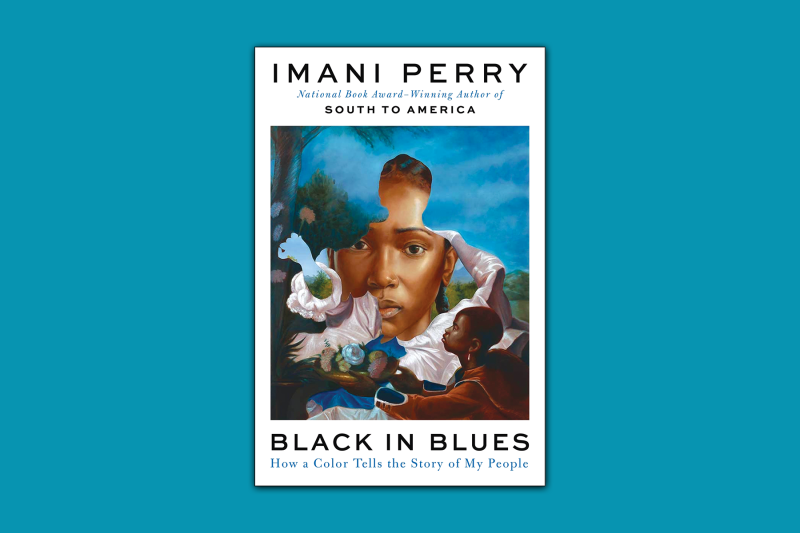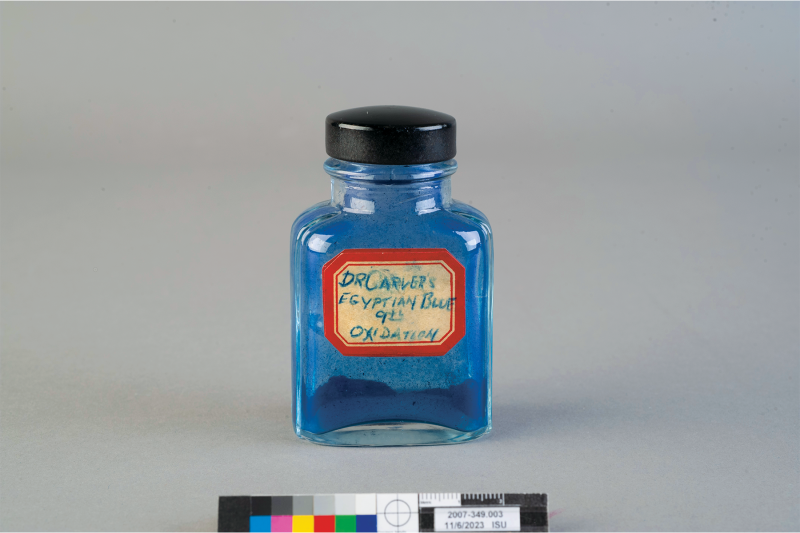COLOR HAS LONG fascinated me. I spend days or weeks debating color choices for knitting and art projects. As a kid, I loved mail-order catalogues for their distinctively named palettes. My shelves teemed with books containing facts about color — names for various shades, how ancient pigments were made (crushed insects, plant extracts, and sea snail secretions), and the meanings of colors in different cultures. Highly conscious of racial differences, I found this last topic compelling. I would match my favorite color that week (it changed constantly) to the meanings provided and see where my tastes aligned.
Through blue, Perry shows us what it means to read for Black desire amid joy, pain, melancholy, loss, terror, and celebration.
While I recall few details — such as white is a color for mourning in Japan — what I remember, unfailingly, is absence. Each time I enacted this color-play-as-identification, I imagined my way into a past, land, and set of values other than my own. Because, as with most Western maps of world cultures then and now, the cultural diversity of Africa and Afro-diasporic peoples was not represented.
Imani Perry’s latest book shows this absence to be a speaking one.
blue2.png

Black in Blues: How a Color Tells the Story of My People is Perry’s meditation on the meaning and presence of blue in Black life. Perry — an acclaimed scholar of race, literature, law, and culture, a National Book Award winner, and a MacArthur Fellow — writes about color with historical acuity, aesthetic insight, and tenderness. Blue, she shows, is a portal to Blackness — as a lived and varied global experience and as a racial category born of systemic violence and oppression that yet exceeds such parameters in its livingness.
Perry fluidly shifts between memoir, history, biography, cultural criticism, and ethnography to traverse geographies, eras, and topics political, botanical, genealogical, ornithological, and more. In Black life, blue expresses wonder, beauty, pain, and everything in between. Periwinkle, navy, teal, cornflower, indigo, sky, azure, and midnight form a spectrum for ceramics, textiles, books, bodies, and beyond, from the indigo dye pits of Nigeria to the blue tile of Perry’s grandmother’s house in Alabama.
Black in Blues is studded with historical figures. Haitian revolutionary warrior Victoria Montou (aka Abdaraya Toya) wore blue and carried an indigo knife from her days as a West African Dahomey soldier. New York ceramicist Thomas Commeraw, born in the late 1700s, made valuable, beautiful blue pots. And musicians across centuries have shaped haunting blue notes and scales bridging the Old and New Worlds.
This is a spiritual book. Perry explores a staggering collection of religious references with a culture critic’s eye and the voice of one who has been cracked open and moved by spiritual experiences of grief, love, and loss. She shows how cultural sites, figures, and histories shape a blue-toned theological continuum of aesthetics and ethics, both positive and negative. For example, through Perry’s expositions of Black Southern folklore about jaybirds and Liberian oral tradition about the origins of indigo, we confront spiritual ideas of good, evil, divinity, trickery, sorrow, and survival. And through historicizing the racializing apparatus of “blue-black,” “blue gums,” and “blue-eyed negroes,” we consider how legacies of colorism, hypodescent (the one-drop rule), and other conundrums and fictions of race have been violently and bodily maintained. We see how Black people have woven meaning and life in and among these systems, at times upending them with daily, blue-noted affirmations of Black’s beauty.
Perry’s portrait of George Washington Carver exemplifies this dynamic, showing him not as a singular, exceptional figure, but connected to his students, colleagues, and Tuskegee surroundings. He emerges as a root worker in conversation with the medicinal and spiritual traditions, value systems, botanical knowledge, and landscapes of rural Black Alabamians. Carver — an inventor, scientist, professor, and artist accomplished in painting and needlepoint — once said, “The first thing one must learn about a sweet potato is that it is a morning glory,” naming a family of more than 1,000 species. He called us to heed and celebrate nature’s variety, and specificity. In addition to documenting more than 300 uses for the peanut, Carver re-created an ancient pigment, “Egyptian blue,” that previously (and famously) couldn’t be replicated in the Western world for thousands of years.
blue3.png

Carver’s attunement to nature and the land is in concert with that of others. Perry cites the carefully cultivated morning glory vines adorning the home of Tildy Collins, a Black woman interviewed by a Works Progress Administration worker so stunned by the flowers that she notes them in the interview. Something about blue demands remembrance, even when others want to forget. When white gatekeepers in the American Upper South denied headstones to the “unfree,” enslaved people marked their graves with periwinkle flower beds.
“Self-regard takes many forms,” Perry writes, “and it is the precondition for seeing to a future not yet realized but deeply yearned for — that is freedom. These traces of blue are evidence.” Through blue, Perry shows us what it means to read for Black desire amid joy, pain, melancholy, loss, terror, and celebration.
In this, she is like Black historical romance writer Beverly Jenkins, whose work inspired my current dissertation research. Black in Blues evokes Jenkins celebrated 1996 historical romance Indigo. Jenkins’ heroine, a dark-skinned Underground Railroad conductor named Hester in 1850s Michigan, has hands and feet permanently dyed blue from her childhood enslavement on an indigo plantation in the South Carolina Sea Islands. (This creative image of indigo-dyed flesh is also found in Julie Dash’s 1991 Daughters of the Dust, a groundbreaking film that also informs Perry’s book.) Hester’s attitude toward her blue-tinged body morphs from concealing it as an emblem of shame and mark of enslavement to embracing it as an erotic site worshipped by the hero. Black women readers responded to Indigo as a powerful tribute to phenotypic Blackness in its darkest shades, championing their beauty against colorism.
Like Indigo or Barry Jenkins’ 2016 film Moonlight, with its striking blue vistas, Perry evinces blue as a present language and a felt sanctuary for Black embodiment.
She has opened an expansive conversation about color that blows past the silences of the art books of my youth. Her book is at home with others, such as Robin Wall Kimmerer’s Braiding Sweetgrass and the illustrated 1619 Project children’s book, Born on the Water, by Nikole Hannah-Jones and Renée Watson — challenged and banned books that resist attempts to whitewash history. Black in Blues, with a range of tones and hues, traces a people’s past, present, and, implicitly, future, reminding us that color cannot be so easily muted.

Got something to say about what you're reading? We value your feedback!

